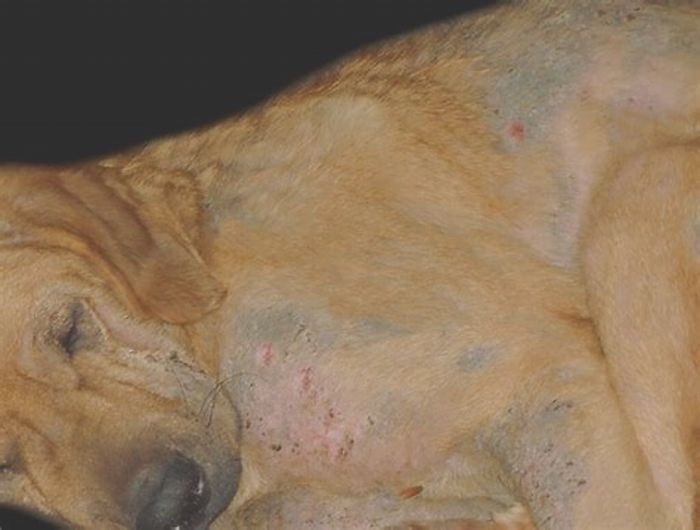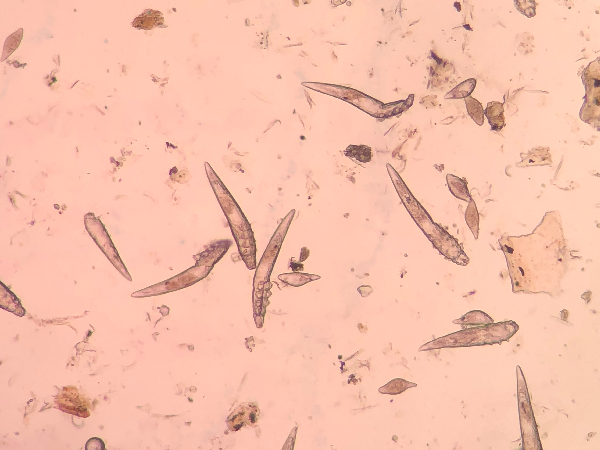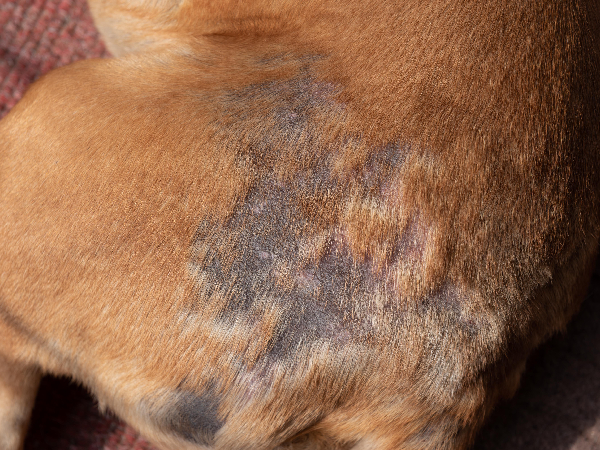What do dog mites look like

What do dog mites look like and how to get rid of them
Brief summary
- Mites are tiny parasites that can infest a dog's skin, ears or fur and cause irritation and inflammation
- Four main species of mites can affect dogs: Demodex, Sarcoptes, Cheyletiella, and Otodectes
- Symptoms include itching, hair loss, scabs and open sores, redness and inflammation
- They can cause various health problems, including skin irritation, skin infections, ear infections, allergic reactions, and reduced quality of life.
- Preventative measures for mites include preventative medication, regular grooming, a healthy diet, and maintaining a clean environment
- Pets onpreventative healthcare plans such asPet Health Clubreceive anti-parasitic treatments as part of their membership
What are dog mites?
Mites are tiny parasites, typically smaller than a human hair, that can infest a dog's skin, ears or fur and cause irritation and inflammation. They are part of the arachnid family, the same family that ticks and spiders belong to. Four main species of mites can affect dogs.
Types of mites on dogs
Demodex mites
These mites live naturally on your dog's skin without causing a problem, but if their immune system is altered, they can multiply too quickly and cause skin problems. Demodicosis can occur in young dogs (3-18 months) due to a defect in the immune system, or in older dogs with an immune system weakened by disease.

Sarcoptes mites
These highly contagious mites cause sarcoptic mange. Mange is a very itchy and uncomfortable skin condition and can spread to other dogs and humans. It is often seen in malnourished or stray dogs, and in wild fox populations.
Cheyletiella mites
These are often called "walking dandruff" because theycause excessive scale and dandruff, and due to the appearance of the large, white mites moving around on the skin. Affected dogs may be itchy.
Otodectes mites
These infest a dog's ears and can cause intense itching, head shaking, and ear inflammation.
Not all mites cause problems for dogs. However, if you suspect your dog has a mite infestation, you must speak to your vet to decide on the best steps.
Symptoms of dog mites
The symptoms of mites depends on the type and how bad the infestation is, but common symptoms typically include the following:
Some dogs may not show any symptoms, especially in the early stages of infestation.

How do dogs get mites?
Mites, like fleas, can be passed from dog to dog through close contact. This could be when they are playing together, sleeping next to each other or if they have been at doggy daycare or boarding kennels. They can also be passed indirectly from dog to dog through feeding bowls, bedding and toys. The exception is Demodex mites, which are passed from mother to pup soon after birth and are then not contagious between adult dogs.
What causes dog mites?
The causes of mites depend on the type of mite. Some common causes include:
- Weakened immune system: Demodex mites, usually present on a dog's skin, can overgrow and cause skin problems when a dog's immune system weakens.
- Direct contact with an infected animal: Sarcopes, Cheyletiella and Otodectesmites are highly contagious and can be transmitted from one dog to another through direct contact.
- The dog's environment: Walking dandruff mites can be transmitted through contaminated bedding, furniture, or carpets.
Some dogs may be more prone to mite infestations due to underlying health conditions, stress, or other factors such as malnutrition. Because mites can be passed on indirectly, keeping your dog's environment clean is essential.
What do dog mites cause?
Mites in dogs can cause various health problems, depending on the mite type and the infestation's severity. Some common health problems caused by mites in dogs include:
Skin irritation
Mites can cause skin irritation, including itching, redness, inflammation, and hair loss.
Skin infections
Scratching and biting at the affected areas can lead to secondary skin infections, which can cause further discomfort and require treatment with antibiotics or other medications.

Ear infections
Otodectes mites infest a dog's ears and can cause intense itching, inflammation, and ear canal infections.
Allergic reactions
Some dogs may be allergic to mites, which can cause additional symptoms such as hives, swelling, and respiratory problems.
Reduced quality of life
Severe mite infestations can cause dogs to feel uncomfortable, lethargic, and less interested in food or play.
When should I see my vet?
If you notice your dog scratching more than usual or notice changes to the skin such as hair loss, redness, sores or excess dandruff, you should visit your vet as soon as possible. The issues caused by mites in dogs are easier to treat with early detection. Pets onpreventative healthcare plans such asPet Health Clubreceive anti-parasitic treatments as part of their membership.

Mite treatment for dogs
Mites are diagnosed through a combination of a physical examination, skin scrapings, and other tests.
Physical examination:
Your vet will thoroughly examine your dog, checking for signs of skin irritation, hair loss, and other symptoms of mite infestations.
Skin scrapings:
Mites are very tiny, so your vet may take a sample of your dog's skin cells or fur to examine under a microscope. They can then identify the type of mite and the severity of the infestation.
Skin biopsy:
Sometimes, your vet may recommend a skin biopsy to examine the affected area further and rule out other skin conditions.
Blood tests:
Your veterinarian may recommend blood tests to check for underlying health conditions contributing to your dog's symptoms.
Once a diagnosis of mites is made, your vet will come up with a treatment plan based on the type of mite and the severity of the infestation. Mite treatment in dogs may include topical or oral medications, shampoos, or antibiotics to treat secondary infections. The mite life cycle is typically a few weeks long, and multiple treatments may be needed to fully resolve the problem.
How to get rid of mites on dogs
There are lots of ways to help your dog stay free of mites.
Grooming
Grooming is essential for your dog. Keeping your dog clean and well groomed will not only help rid them of parasites but will also keep their coat clean and soft, allow you to check for any cuts, scrapes, lumps or bumps and provide a way to bond with your dog.
Washing your dog should only really happen when they are particularly dirty or have rolled in something disgusting, or under the direction of a vet for certain skin conditions. Always use a dog-specific shampoo, as human (especially baby) shampoos can be unsuitable for dogs skin.
Keeping your dog's ears clean is incredibly important. Check them regularly and wipe them with a wet cloth to clean them out. You should only clean the visible outer portion of the ear: never poke anything down the ear canal, including cotton buds. If your dog is shaking their head or pawing at their ears, see your vet; they can flush their ears and thoroughly clean them out.

Healthy diet
A healthy diet will help keep their coat and skin in great shape and make them an unattractive place for mites to live. Your dog's diet should include proteins, fats and carbs in balanced proportion, as well as micronutrients such as vitamins and minerals. Speak to your vet for more advice on the best diet for your dog.
Clean environment
Clean bedding will help prevent mites from spreading indirectly. Keep your home clean and well-ventilated, avoid taking your dog to unclean places and don't let them interact with dogs with open sores or areas of fur missing, as they may suffer from mites or mange and could quickly infest your dog. Keep wildlife such as foxes out of gardens where possible.
Common questions about mites
What do dog mites look like?
Cheyletiella mites, though appearing as tiny black dots on the skin, are actually white and a tad larger than they seem. Under a microscope, their true form comes to light, showing a blend of a tick and a spider. As these mites are hard to spot with the naked eye, it's important to keep a close watch on your dog's behaviour and the condition of their skin.
What happens if dog mites go untreated?
Whilemites aren't fatal, if left untreated, they can lead to severe skin changes, which can cause discomfort, pain and distress.. If you think your dog has mites, then seek veterinary attention.
Can dog mites jump onto humans?
Humans can catch sarcoptic mites from dogs. They can cause skin irritation in humans, which is usually self-limiting as the mite can't complete their life cycle on human skin. It can be treated with ointments and creams. Uncommonly, Cheyletiella and Otodectes mites can also be passed to humans.

Need more info?
If youve any questions aboutprotecting your puppy or dog, just call or visit your local vet.
Find your nearest vet using ourFind a Vetpage, or speak to a vet online usingOnline Vets.
Ear Mites in Dogs
What Are Ear Mites in Dogs?
Ear mites are highly contagious parasites that live inside and around ear canals. The dog ear mite belongs to the Psoroptidae family, which is a group of parasitic mites that live on the surface of the skin rather than burrowing into it, as some types of mites do.
Their scientific name is Otodectes cynotis. They tend to be less than half of a millimeter long and can be seen best under a microscope. These mites affect various species, including dogs, cats, rabbits, ferrets, and occasionally livestock.
Symptoms of Ear Mites in Dogs
Ear mites cause an intense itch. The most common symptoms of a dog ear mite infection include:
Scratching and rubbing at the ears
Shaking the head
Dark discharge from the ears
Hair loss, skin lesions, and secondary skin infections, which can develop around the ears, head, and neck from all the scratching and rubbing
Bacterial and yeast ear infectionscan look like ear mite infestations. If you suspect something is up with your dogs ears, contact your veterinarian for an exam.
Causes of Ear Mites in Dogs
Dogs get ear mites by being around other animals that are infested with these parasites.
To understand how dogs get ear mites, its important to understand the mite life cycle. Adult mites lay eggs that mature into larvae, grow through two stages of nymphs, and then become adults. It takes about three weeks for an egg to become a full-grown ear mite.Adult mites can live for approximately two months.
The mites feed on your dogs ear and skin surface debris, which causes inflammation and irritation. The mite is transmitted from one animal to another through physical contact.
Because ear mites are so contagious, you must treat all susceptible animals in your home simultaneously to eliminate them, even if just one pet is diagnosed.
How Vets Diagnose Ear Mites
A dog with an ear infection can have the same symptoms (scratching and ear discharge) as a dog with ear mites. Thats why its important to see your veterinarian for help with diagnosis and treatment.
Making a diagnosis allows for appropriate medication for treatment. Using the wrong medication can be dangerous and/or cause discomfort to your petplus, its a waste of time and money. And if your dogs eardrum is ruptured, only certain medications can be used, which is why seeing the vet is oh-so-important.
For an official diagnosis, your veterinarian will typically look in your dogs ears with an otoscope and take an ear swab to look for both mite eggs and adult mites under a microscope. Your vet may also run an ear cytology to rule out secondary or concurrent bacterial or yeast infections. Sometimes a skin scrape will also reveal the mite.
Ear Mite Treatment for Dogs
Treatment for ear mites in dogs involves both cleaning the ears and giving the dog medication.
Cleaning your dogs ear canalremoves debris and buildup, allows medication to be more effective, and helps return the ear canal to normal, healthy tissue. Your vet will clean your dogs ear and show you how to clean them yourself at home, if needed.
Medication for ear mites can include:
While some of the topical medications for your dogs ear canal can be single-use, others must be applied daily for seven to 30 days. Your veterinarian will make a medication decision based on your pets individual situation.
Treatment also requires that all household pets receive medicine so they dont continue to reinfect each other. Ask your veterinarian about appropriate treatments specific to each of your pets.
Recovery and Management of Dog Ear Mites
Most dogs make a relatively quick, uneventful recovery from ear mites, although some dogs might have an ongoing battle with the pesky mites. Veterinarians may recommend a follow-up examination to make sure that a dogs ears are back to normal. If theyre not, the vet will provide additional treatments.
Sometimes theres residual debris in your dogs ear canal that needs to be flushed. And if theres also a bacterial or yeast infection, your vet may need to prescribe additional medication or a different medication to address the infection.
Future ear mite infestations can also be prevented with many of the same products that are used to prevent fleas, ticks, and other types of parasites.
After treatment, continue to check your dogs ears regularly for signs of ear mites or other problems. Look for discharge or redness within the ear canal, and headshaking or scratching around the ears.
Ear Mites in Dogs FAQs
Can humans get ear mites from dogs?
Yes, humans can get ear mites from an infected dog. Its not common, but its possible. More frequently, other pets in the home get infected with the ear mites from a contagious dog.
What home remedy kills ear mites in dogs?
Little research has been done to examine the safety and effectiveness of home remedies for dog ear mites. Since there are so many safe and effective medications readily available, you should always see your veterinarian to prescribe a medication for treatment.
Will tea tree oil kill ear mites in dogs?
Do not use tea tree oil on your dog or put it in their ear. Undiluted tea tree oil should never be given to dogs, as it can be very toxic. Although diluted tea tree oil is thought to have some antibacterial and antifungal properties,it can cause burning, stinging, and damage to an inflamed ear.
Because there are safe, proven products available to treat ear mites in dogs, you should have your veterinarian prescribe one of those instead.
Does hydrogen peroxide kill ear mites in dogs?
Hydrogen peroxide can be very painful when used in inflamed ears. It can also slow healing and damage sensitive tissues. Do not use hydrogen peroxide to treat dog ear mites.
What medication kills ear mites in dogs?
There are many products known to kill ear mites in dogs, including:
Your veterinarian can recommend the right product based on your dogs particular needs.
References
Brooks, W.
Featured Image: iStock/skynesher
Brooks, W.
Featured Image: iStock/skynesher
WRITTEN BY
Amanda Simonson, DVMVeterinarian
I am a veterinarian passionate about helping animals. I practiced for 15 years in the hospital setting doing medicine, surgery, preventive...









